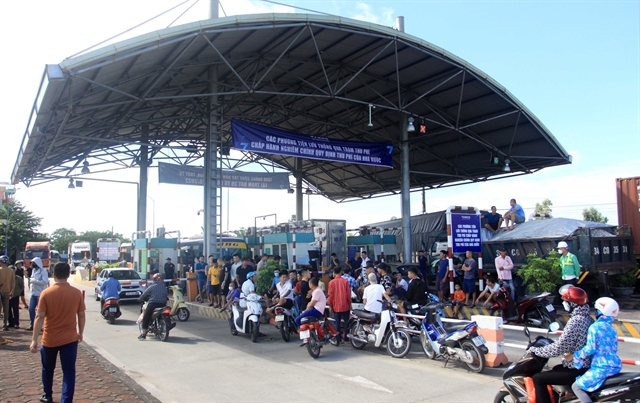 Economy
Economy


|
| Locals gather at a toll collection booth in the northern province of Thái Bình. — VNA/VNS Photo |
HÀ NỘI — Investors of transportation BOT (Build-Operate-Transfer) projects must look to diversify their financing as domestic commercial banks have not been willing to loosen the purse strings, said the State Bank of Vietnam.
According to the central bank, commercial banks have long considered BOT projects as high-risk and often unwilling to jump in. In a report to the National Assembly (NA), the SBV said as of September 30, 22 financial institutes agreed to extend credit to transportation BOT projects, whose total outstanding balance has reached over VNĐ92.3 trillion (US$3.8 billion).
Meanwhile, the bank said the ratio of non-performing loans has been a cause for concern with non-performing loans of the transportation sector accounting for 3.83 per cent of the total. As much as 26.52 per cent of the loans were put on a special watch list by the bank.
The SBV said the main reason behind the high percentage of non-performing loans was a lack of financial capacity by most investors. In addition, many BOT projects have reported a decline in revenue in comparison to projected revenue in the initial business plan as they struggled with recent regulation changes in toll collection policy and disputes with local communities.
As a result, investors have voiced their concerns over financial challenges and losses. A recent report by the Ministry of Transport said as many as eight BOT projects were having difficulties generating revenue, including the Western Bypass of Thanh Hóa City, the construction of the Bình Lợi Railway Bridge, the construction of the Thái Nguyên-Chợ Mới Road, and the upgrade of National Highway 3, the section of the Hồ Chí Minh Road through the Central Highlands, and the renovation of National Highway 91 in southern Cần Thơ City.
According to the central bank, the total credit outstanding for the above-mentioned projects has reached over VNĐ15.85 trillion.
Representatives from commercial banks said revenue generated by BOT projects have often failed to meet the banks' expectation as many have been experiencing issues in collecting toll and reduced revenue from competition.
"Without a source of stable revenue, investors cannot pay off principal and interest on time, which will put them on a no-loans list, denying them access to new capital. Meanwhile, banks must also set aside provision for the at-risk loans, heavily hindering their own business operations," said a bank representative.
During an NA's session, NA Deputy Nguyễn Đại Thắng from northern Hưng Yên Province suggested investors start diversifying their funding sources, including looking into the international financial market. He also urged the central bank to provide additional support to investors in seeking out capital.
Speaking to NA deputies, SBV Governor Nguyễn Thị Hồng said as most domestic financial institutes prefer short-term loans, finding long-term loans in such large quantities, as often required by transportation projects, will likely be challenging.
On the other hand, industry experts said some banks may have classified their non-performing loan prematurely as the life cycle for transportation BOT projects have just been extended from 20 years to 25 years. They said it's unreasonable to judge projects by looking at their generated revenue in the first few years of operation. — VNS